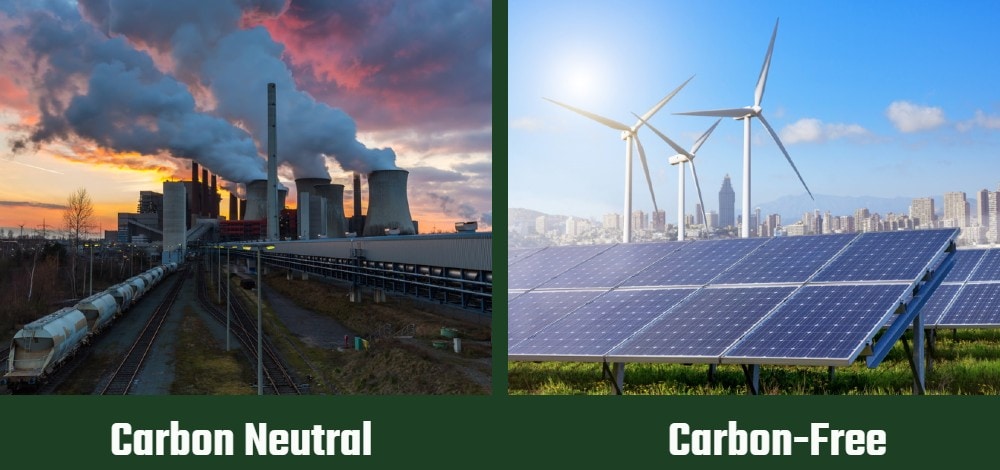Carbon Neutral Vs Carbon-Free: What’s the Difference?
-
- Last updated:

Due to the ongoing climate crisis, governments, corporations, communities, and individuals are all trying their best to play their part in mitigating or slowing down the looming potential disaster.
However, not all actors have been sincere in their efforts. This situation has made many environmentally-conscious people wary of trusting just anyone who claims to be going green. One area that has created a lot of contention is the proper definition of terms.
Another is if the elements we’re warned against actually harm the environment, and if so, to what extent?
At the center of this debate is the role played by carbon emissions in climate change. Carbon dioxide is the most impactful greenhouse gas, responsible for two-thirds of the total energy imbalance causing global warming.
Therefore, controlling carbon emissions is a matter of global importance. But first, let’s discuss what exactly we mean by “carbon neutral” and “carbon-free,” and the role of each in the fight against climate change.

Overview of the Carbon Neutral Concept
Carbon neutral is a state where carbon dioxide emissions are maintained at a net value of zero. This state of net-zero carbon emissions is achieved by compensating for any carbon dioxide emission by ensuring its removal from the atmosphere.

How is a Carbon Neutral State Achieved?
To achieve a carbon-neutral state, an effective method of removing all or most of the carbon dioxide produced needs to be established. Some ways of removing carbon dioxide from the environment include:
- Planting trees
- Storing carbon dioxide in farms
- Carbon capturing and storage
- Iron fertilization
Plants absorb carbon dioxide for photosynthesis, the process by which they make their food from sunlight. Farms can store carbon dioxide in the soil by planting cover crops or adding compost and manure to the soil.
Carbon capturing technology can achieve up to 90% efficiency and is being incorporated in large industries.
Another method of capturing carbon dioxide is iron fertilization, where iron dust is introduced to parts of the ocean to stimulate the growth of phytoplankton. These absorb carbon dioxide the same way that plants do: through photosynthesis.

Challenges to Carbon Dioxide Removal
The method is only effective if the amount of carbon dioxide emitted in an area is calculated, and effective methods to remove it are put in place. If this is not done, then neutrality is not achieved. Instead of neutrality, all that is gained is a slight reduction of carbon dioxide in the atmosphere.
Carbon removal methods are also slow. Plants absorb carbon dioxide at a fixed rate. The only way to increase the amount of carbon dioxide absorbed is to increase the number of plants. And as you know, no plant grows in a day.
For carbon capturing and storage, the more efficient the device, the more expensive it becomes. Iron fertilization has the potential to negatively affect ocean ecology, in addition to possibly being counterproductive.

Overview of the Carbon Free Concept

Being carbon-free means two things:
- No carbon dioxide is being emitted
- No fossil fuels are being used
In the case of being carbon-free, emission of carbon dioxide is eliminated instead of being compensated for.
How is a Carbon-Free State Achieved?
One of the most effective ways to achieve a carbon-free state is to switch to renewable or green energy sources such as solar, nuclear, wind, and biomass energy.
Other ways include reducing energy waste by only using home appliances when needed, insulating your home, and reducing meat intake: especially beef.

Challenges to Achieving a Carbon-Free State
We humans have built our world in a way that relies heavily on fossil fuels. Our primary waste products are also carbon-based. Apart from drastic policy changes, individuals have to make life-altering changes to their daily lives. Motivating enough people to make these changes is difficult, especially since not everyone is in a position to make the changes required.
However, the previous point only applies where people are willing to make a difference. Getting people to cooperate around the world has been a conflict-ridden process. Propaganda against climate change has gone so far as to convince people that the issue is nothing more than a conspiracy.

Which is Better?
Now that we understand the difference between carbon neutrality and being carbon-free, which one should we prioritize? The answer is a little bit of both.
Methods of removing carbon dioxide are convenient but not perfect. They’re slow and can get very expensive. However, if the amount of carbon dioxide emitted is controlled and even eliminated where possible, carbon removal methods become more effective.
The best approach is to find where the two concepts can complement and enhance each other.

Conclusion
The climate crisis is an urgent issue. We need an effort from every citizen, every community, and nation. Learning different concepts and how they can be used to improve the situation is a great place to start our journey.
Hopefully, we will someday get to a carbon-negative world, whichever route we use to get there.
- https://www.frontiersin.org/articles/10.3389/fmars.2019.00022/full
- https://nap.nationalacademies.org/resource/18988/climate-intervention-brief-final.pdf
- https://climate.mit.edu/ask-mit/how-efficient-carbon-capture-and-storage
- https://www.climate.gov/news-features/understanding-climate/climate-change-atmospheric-carbon-dioxide
- https://climate.nasa.gov/evidence/
Featured Image Credit: Left: Carbon Neutral: r.classen, Shutterstock | Right: Carbon Free: artjazz, Shutterstock
Contents

